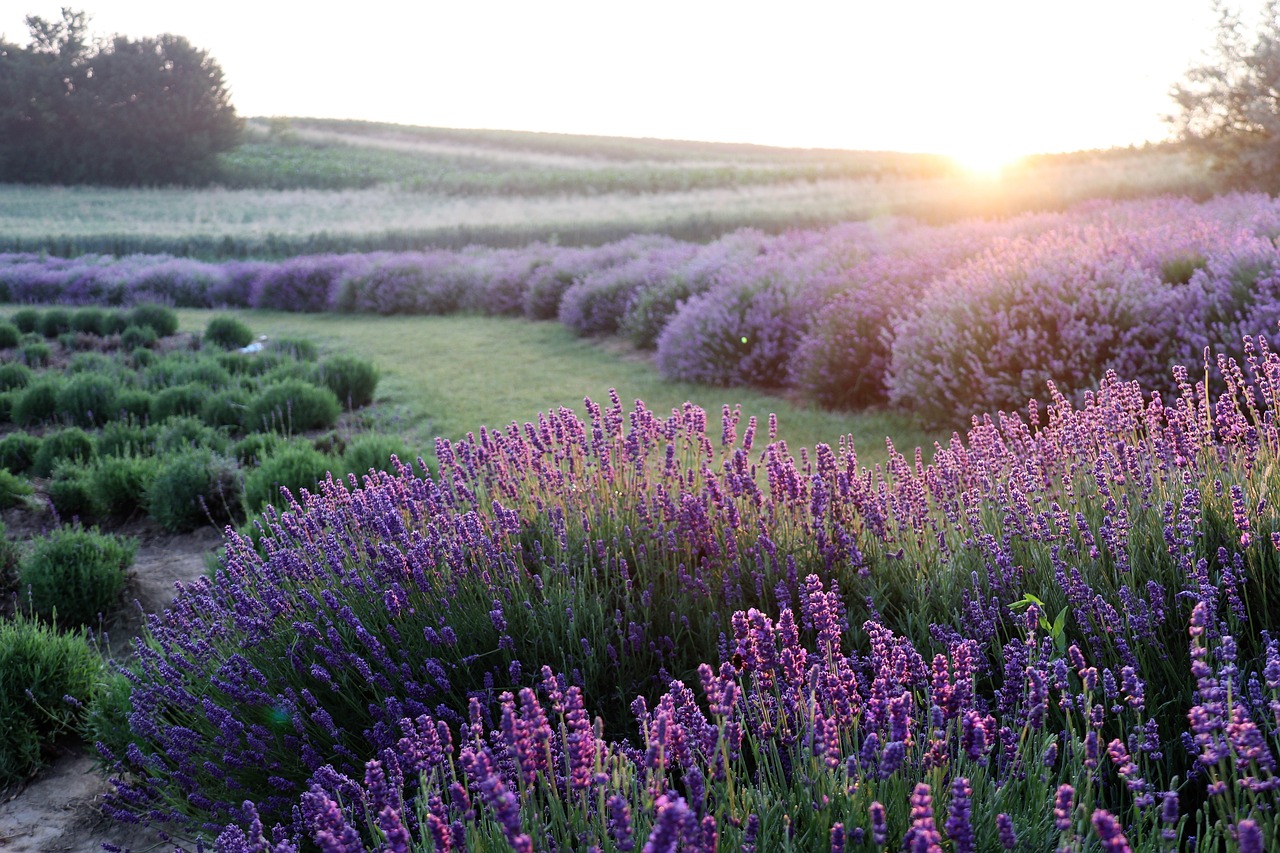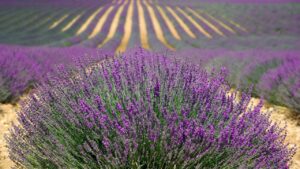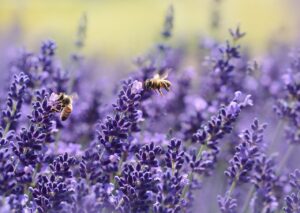Lavender
Overview
Lavender, or Lavandula angustifolia, is a perennial herb belonging to the mint family, valued for its aromatic flowers and versatile oil. Noted for its soothing properties and captivating fragrance, lavender is a multitasking botanical, used in traditional medicine, culinary creations, and a range of personal care products.
Common name(s): English lavender, true lavender
Scientific name: Lavandula angustifolia

Characteristics
Known for its fragrant purple flowers, calming properties, and usage in aromatherapy, perfumery, and culinary applications.
Region
Native to the Mediterranean region; widely cultivated in sunny, well-drained areas.
Natural Habitat
Mediterranean region in sunny, well-drained locations.
Cultivation
Prefers full sun, well-drained soil, and minimal water once established, tolerant to drought.
Traditional Usage
Lavender has been valued for its versatile uses for centuries, embracing both the physical and mental aspects of well-being. Its calming and soothing properties have made it a cornerstone in the realm of herbal remedies.
Traditional uses of lavender include:
- Promoting relaxation to ease the mind from daily stresses.
- Utilized in aromatherapy for reducing anxiety and improving sleep quality.
- Used topically as an antiseptic due to its anti-inflammatory properties3.
- Enhancing a range of products such as soaps, lotions, and perfumes with its signature fragrance4.
- Adding a special floral flavor to teas, baked goods, and other culinary items4.
Modern research supports these traditional applications, suggesting the potential of lavender to also help manage pain and inflammation due to the presence of various active compounds like linalool6. Even though smoking lavender isn’t widely practiced, anecdotal evidence implies that it might replicate similar calming effects experienced through other methods of use7. However, it’s essential to note the health risks associated with smoking and to consult with a healthcare professional before pursuing this method for medicinal purposes.
Historical Usage
Used traditionally for its sedative properties to alleviate anxiety, improve sleep, and soothe ailments.
Common Usage
Used in soaps, lotions, perfumes, teas, and baked goods for fragrance and flavor.
Effects
Lavender is widely recognized for its calming and soothing properties. Many people use it to help with sleep, as inhaling lavender’s scent has been shown to improve sleep quality. It’s not just a sleep aid, though; lavender can also be beneficial for reducing anxiety and creating a sense of relaxation. This herb has been associated with lowering heart rate and blood pressure, potentially contributing to a more relaxed state.
The effects of lavender extend beyond relaxation:
- Pain relief: Can alleviate various forms of pain, including headaches and sore muscles.
- Anti-inflammatory properties: May reduce inflammation, aiding in the relief of conditions like arthritis.
- Antimicrobial effects: Known to help fight against certain bacteria and fungi.
- Skin healing: When applied topically, it can promote faster healing of minor burns and insect bites.
- Anti-nausea: Can help alleviate symptoms of nausea, making it a subtle remedy for upset stomachs.
These benefits make lavender a versatile herb for overall well-being. With its delicate fragrance and wide range of uses, it’s a popular choice for those seeking natural remedies for everyday ailments.

Lavender: A natural remedy renowned for promoting relaxation and alleviating stress.
Effects when smoking
Smoking lavender may deliver a tranquil experience due to the presence of linalool, a compound known for its calming properties5. Although not a mainstream practice, those who have smoked lavender report a sense of relaxation akin to what is experienced through aromatherapy7. It’s important to approach this with caution and to consider potential risks:
- May induce a feeling of calmness and relaxation.
- Reported anecdotally to reduce anxiety and promote a sense of well-being.
- Potentially beneficial for improving sleep quality due to its soothing effects.
- Contains fragrant compounds that could offer a pleasurable aromatic experience.
Always bear in mind that smoking, in general, carries health risks, and it’s advisable to consult with a healthcare professional before smoking lavender for medicinal purposes. Smoking is not the recommended primary method for consuming lavender, due to the lack of extensive research on its effects when inhaled in this form7.
Flavor Profile
Distinctive floral aroma with hints of sweetness and herbaceous notes.
Edible Parts
Flowers and leaves.
Effects when Smoked
Smoking may produce a calming and relaxing effect, akin to its use in aromatherapy. However, health risks associated with smoking should be considered, and it is not recommended as a primary method of consumption.
User Experiences
Individuals often report feeling relaxed and calm, with some experiencing improved sleep and a decrease in anxiety.
Medicinal Benefits
Lavender is widely recognized for its calming and soothing properties. Many people use it to help with sleep, as inhaling lavender’s scent has been shown to improve sleep quality. It’s not just a sleep aid, though; lavender can also be beneficial for reducing anxiety and creating a sense of relaxation. This herb has been associated with lowering heart rate and blood pressure, potentially contributing to a more relaxed state.
The effects of lavender extend beyond relaxation:
- Pain relief: Can alleviate various forms of pain, including headaches and sore muscles.
- Anti-inflammatory properties: May reduce inflammation, aiding in the relief of conditions like arthritis.
- Antimicrobial effects: Known to help fight against certain bacteria and fungi.
- Skin healing: When applied topically, it can promote faster healing of minor burns and insect bites.
- Anti-nausea: Can help alleviate symptoms of nausea, making it a subtle remedy for upset stomachs.
These benefits make lavender a versatile herb for overall well-being. With its delicate fragrance and wide range of uses, it’s a popular choice for those seeking natural remedies for everyday ailments.
History and Folklore
Historically, lavender has been prized for its medicinal properties and enchanting fragrance. Used extensively in traditional herbal medicine, it was relied upon for its calming and soothing effects. Lavender earned its place in homes and healing spaces by promoting relaxation and aiding sleep. Moreover, its antiseptic and anti-inflammatory qualities were well-regarded. Beyond health, lavender also graced perfumes and cosmetics, adding its signature scent to a variety of products[1].

Historical use: Lavender has been a prized plant throughout the ages, used by Romans in baths, by Egyptians in mummification, and by Greeks for its healing properties.
Side Effects and Contraindications
While lavender is generally recognized as safe, some individuals may notice side effects or contraindications. Potential side effects include:
- Skin irritation when the essential oil is applied topically
- Allergic reactions, which are rarely reported
- Nausea, vomiting or headaches if large amounts of essential oil are ingested — a practice that is discouraged due to its toxicity at high doses9.
Contraindications may apply to certain individuals and it is crucial to consult with a healthcare provider before use if you:
Legal Status
Lavender is considered legal to grow, sell, and use in a variety of applications in most countries around the world. However, it is crucial to be aware of and adhere to any local laws and regulations that pertain to the cultivation and use of the herb. There may be regional variations in its legal status, which is why checking with the appropriate authorities is advised before proceeding with any activity related to lavender10. This ensures responsible usage and compliance with the law.
References
- Prusinowska, R., & Śmigielski, K. B. (2014). Composition, biological properties and therapeutic effects of lavender (Lavandula angustifolia L.). A review. Herba Polonica, 60(2), 56-66.
- Upson, T., & Andrews, S. (2004). The genus Lavandula. Royal Botanic Gardens, Kew.
- Koulivand, P. H., Khaleghi Ghadiri, M., & Gorji, A. (2013). Lavender and the nervous system. Evidence-Based Complementary and Alternative Medicine, 2013.
- Cavanagh, H. M. A., & Wilkinson, J. M. (2002). Biological activities of lavender essential oil. Phytotherapy Research, 16(4), 301-308.
- Kasper, S., Gastpar, M., Müller, W. E., Volz, H. P., Möller, H. J., Schläfke, S., & Dienel, A. (2014). Lavender oil preparation Silexan is effective in generalized anxiety disorder–a randomized, double-blind comparison to placebo and paroxetine. International Journal of Neuropsychopharmacology, 17(6), 859-869.
- Silva, G. L., Luft, C., Lunardelli, A., Amaral, R. H., Melo, D. A., Donadio, M. V., … & Oliveira, J. R. (2015). Antioxidant, analgesic and anti-inflammatory effects of lavender essential oil. Anais da Academia Brasileira de Ciências, 87(2), 1397-1408.
- Russo, E. B. (2011). Taming THC: potential cannabis synergy and phytocannabinoid-terpenoid entourage effects. British Journal of Pharmacology, 163(7), 1344-1364.
- Shellie, R., Mondello, L., Marriott, P., & Dugo, G. (2002). Characterisation of lavender essential oils by using gas chromatography–mass spectrometry with correlation of linear retention indices and comparison with comprehensive two-dimensional gas chromatography. Journal of Chromatography A, 970(1-2), 225-234.
- Prashar, A., Locke, I. C., & Evans, C. S. (2004). Cytotoxicity of lavender oil and its major components to human skin cells. Cell Proliferation, 37(3), 221-229.
- Zheljazkov, V. D., Cantrell, C. L., Astatkie, T., & Jeliazkova, E. (2013). Distillation time effect on lavender essential oil yield and composition. Journal of Oleo Science, 62(4), 195-199.
Image Credit: Mouse23
Image Credit: No-longer-here
Image Credit: castleguard
Nicolas Duval
Nicolas is a passionate advocate for nature and the art of wildcrafting. His dedication shines through in Wildcraftia, a website he meticulously crafted to serve as a haven for nature enthusiasts worldwide. Driven by a deep appreciation for nature’s connection to humanity, Nicolas embarked on his journey in 2011 with SmokableHerbs, a platform showcasing his love for nature’s bounty. Building upon this foundation, he established Smokably, a thriving online store offering premium herbs and blends to a global audience.
